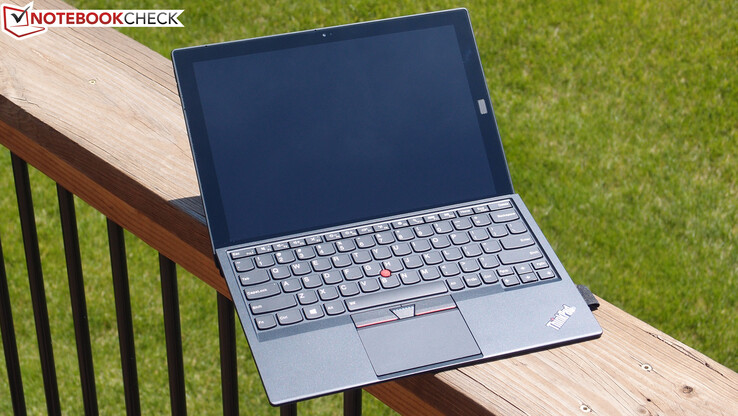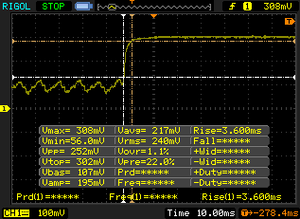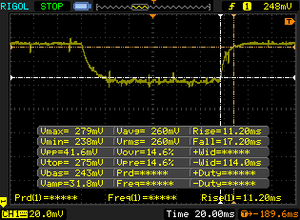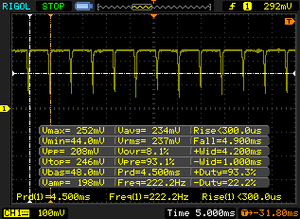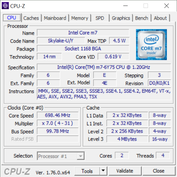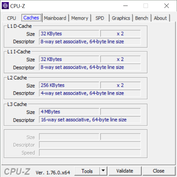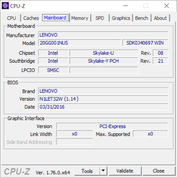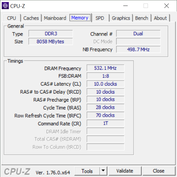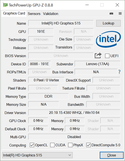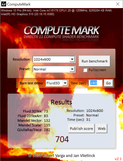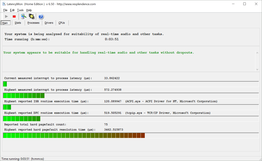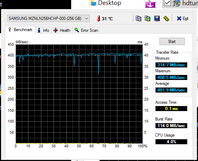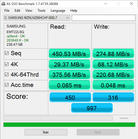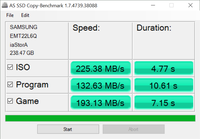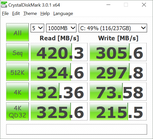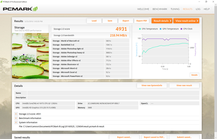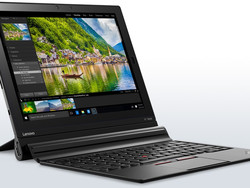Breve Análise do Tablet Lenovo ThinkPad X1
Os Top 10
» Os Top 10 Portáteis Multimídia
» Os Top 10 Portáteis de Jogos
» Os Top 10 Portáteis Leves para Jogos
» Os Top 10 Portáteis Acessíveis de Escritório/Empresariais
» Os Top 10 Portáteis Premium de Escritório/Empresariais
» Os Top 10 dos Portáteis Workstation
» Os Top 10 Subportáteis
» Os Top 10 Ultrabooks
» Os Top 10 Conversíveis
» Os Top 10 Tablets
» Os Top 10 Smartphones
» A melhores Telas de Portáteis Analisadas Pela Notebookcheck
» Top 10 dos portáteis abaixo dos 500 Euros da Notebookcheck
» Top 10 dos Portáteis abaixo dos 300 Euros
| |||||||||||||||||||||||||
iluminação: 85 %
iluminação com acumulador: 342.4 cd/m²
Contraste: 460:1 (Preto: 0.744 cd/m²)
ΔE ColorChecker Calman: 5.33 | ∀{0.5-29.43 Ø4.78}
ΔE Greyscale Calman: 5.36 | ∀{0.09-98 Ø5}
93% sRGB (Argyll 1.6.3 3D)
57% AdobeRGB 1998 (Argyll 1.6.3 3D)
63.9% AdobeRGB 1998 (Argyll 3D)
93% sRGB (Argyll 3D)
62.4% Display P3 (Argyll 3D)
Gamma: 2.12
CCT: 7671 K
| Lenovo ThinkPad X1 Tablet 12", 2160x1440 | Dell XPS 12 9250 4K 12.5", 3840x2160 | HP Spectre x2 12-a003ng K3D42EA 12", 1920x1080 | Asus Zenbook UX305CA-FB055T 13.3", 3200x1800 | Toshiba Portege Z20t-B-10C 12.5", 1920x1080 | Microsoft Surface Pro 4, Core m3 12.3", 2736x1824 | |
|---|---|---|---|---|---|---|
| Display | 32% | -19% | -6% | -32% | 7% | |
| Display P3 Coverage (%) | 62.4 | 83.9 34% | 52.9 -15% | 59.1 -5% | 42.63 -32% | 67.5 8% |
| sRGB Coverage (%) | 93 | 99.8 7% | 71.8 -23% | 85.5 -8% | 63.6 -32% | 96.6 4% |
| AdobeRGB 1998 Coverage (%) | 63.9 | 98.1 54% | 52.6 -18% | 61 -5% | 44.1 -31% | 69 8% |
| Response Times | -63% | -57% | -44% | -69% | ||
| Response Time Grey 50% / Grey 80% * (ms) | 28.4 ? | 36 ? -27% | 47 ? -65% | 38 ? -34% | 46 ? -62% | |
| Response Time Black / White * (ms) | 17.6 ? | 35 ? -99% | 26 ? -48% | 27 ? -53% | 31 ? -76% | |
| PWM Frequency (Hz) | 222.2 ? | 1000 ? | 1429 ? | 50 ? | ||
| Screen | 42% | 7% | 15% | -8% | 44% | |
| Brightness middle (cd/m²) | 342.4 | 437 28% | 353 3% | 390 14% | 342 0% | 389.2 14% |
| Brightness (cd/m²) | 315 | 399 27% | 347 10% | 352 12% | 301 -4% | 392 24% |
| Brightness Distribution (%) | 85 | 81 -5% | 91 7% | 81 -5% | 76 -11% | 92 8% |
| Black Level * (cd/m²) | 0.744 | 0.35 53% | 0.44 41% | 0.69 7% | 0.393 47% | 0.27 64% |
| Contrast (:1) | 460 | 1249 172% | 802 74% | 565 23% | 870 89% | 1441 213% |
| Colorchecker dE 2000 * | 5.33 | 3.56 33% | 6.09 -14% | 3.04 43% | 9.69 -82% | 3.61 32% |
| Colorchecker dE 2000 max. * | 9.25 | 9.3 -1% | 7.01 24% | |||
| Greyscale dE 2000 * | 5.36 | 2.67 50% | 6.24 -16% | 2.88 46% | 9.27 -73% | 3.8 29% |
| Gamma | 2.12 104% | 2.17 101% | 2.41 91% | 2.43 91% | 2.95 75% | 2.16 102% |
| CCT | 7671 85% | 6681 97% | 7238 90% | 6848 95% | 6010 108% | 5969 109% |
| Color Space (Percent of AdobeRGB 1998) (%) | 57 | 86 51% | 46 -19% | 55 -4% | 40.4 -29% | 63 11% |
| Color Space (Percent of sRGB) (%) | 93 | 100 8% | 71 -24% | 85 -9% | 97 4% | |
| Média Total (Programa/Configurações) | 4% /
26% | -23% /
-8% | -12% /
3% | -20% /
-14% | -6% /
20% |
* ... menor é melhor
Exibir tempos de resposta
| ↔ Tempo de resposta preto para branco | ||
|---|---|---|
| 17.6 ms ... ascensão ↗ e queda ↘ combinadas | ↗ 3.6 ms ascensão | |
| ↘ 14 ms queda | ||
| A tela mostra boas taxas de resposta em nossos testes, mas pode ser muito lenta para jogadores competitivos. Em comparação, todos os dispositivos testados variam de 0.1 (mínimo) a 240 (máximo) ms. » 38 % de todos os dispositivos são melhores. Isso significa que o tempo de resposta medido é melhor que a média de todos os dispositivos testados (20.2 ms). | ||
| ↔ Tempo de resposta 50% cinza a 80% cinza | ||
| 28.4 ms ... ascensão ↗ e queda ↘ combinadas | ↗ 11.2 ms ascensão | |
| ↘ 17.2 ms queda | ||
| A tela mostra taxas de resposta relativamente lentas em nossos testes e pode ser muito lenta para os jogadores. Em comparação, todos os dispositivos testados variam de 0.165 (mínimo) a 636 (máximo) ms. » 37 % de todos os dispositivos são melhores. Isso significa que o tempo de resposta medido é melhor que a média de todos os dispositivos testados (31.6 ms). | ||
Cintilação da tela / PWM (modulação por largura de pulso)
| Tela tremeluzindo/PWM detectado | 222.2 Hz | ≤ 49 % configuração de brilho | |
A luz de fundo da tela pisca em 222.2 Hz (pior caso, por exemplo, utilizando PWM) Cintilação detectada em uma configuração de brilho de 49 % e abaixo. Não deve haver cintilação ou PWM acima desta configuração de brilho. A frequência de 222.2 Hz é relativamente baixa, portanto, usuários sensíveis provavelmente notarão cintilação e sentirão fadiga ocular na configuração de brilho indicada e abaixo. [pwm_comparison] Em comparação: 53 % de todos os dispositivos testados não usam PWM para escurecer a tela. Se PWM foi detectado, uma média de 8118 (mínimo: 5 - máximo: 343500) Hz foi medida. | |||
| Cinebench R11.5 | |
| CPU Single 64Bit (classificar por valor) | |
| Lenovo ThinkPad X1 Tablet | |
| Dell XPS 12 9250 4K | |
| HP Spectre x2 12-a003ng K3D42EA | |
| Asus Zenbook UX305CA-FB055T | |
| Toshiba Portege Z20t-B-10C | |
| Microsoft Surface Pro 4, Core m3 | |
| CPU Multi 64Bit (classificar por valor) | |
| Lenovo ThinkPad X1 Tablet | |
| Dell XPS 12 9250 4K | |
| HP Spectre x2 12-a003ng K3D42EA | |
| Asus Zenbook UX305CA-FB055T | |
| Toshiba Portege Z20t-B-10C | |
| Microsoft Surface Pro 4, Core m3 | |
| Cinebench R15 | |
| CPU Single 64Bit (classificar por valor) | |
| Lenovo ThinkPad X1 Tablet | |
| Dell XPS 12 9250 4K | |
| HP Spectre x2 12-a003ng K3D42EA | |
| Asus Zenbook UX305CA-FB055T | |
| Toshiba Portege Z20t-B-10C | |
| Microsoft Surface Pro 4, Core m3 | |
| CPU Multi 64Bit (classificar por valor) | |
| Lenovo ThinkPad X1 Tablet | |
| Dell XPS 12 9250 4K | |
| HP Spectre x2 12-a003ng K3D42EA | |
| Asus Zenbook UX305CA-FB055T | |
| Toshiba Portege Z20t-B-10C | |
| Microsoft Surface Pro 4, Core m3 | |
| wPrime 2.10 - 1024m (classificar por valor) | |
| Lenovo ThinkPad X1 Tablet | |
| Microsoft Surface Pro 4, Core m3 | |
| Super Pi Mod 1.5 XS 32M - 32M (classificar por valor) | |
| Lenovo ThinkPad X1 Tablet | |
| HP Spectre x2 12-a003ng K3D42EA | |
| Toshiba Portege Z20t-B-10C | |
| Microsoft Surface Pro 4, Core m3 | |
* ... menor é melhor
| PCMark 8 | |
| Home Score Accelerated v2 (classificar por valor) | |
| Lenovo ThinkPad X1 Tablet | |
| Dell XPS 12 9250 4K | |
| HP Spectre x2 12-a003ng K3D42EA | |
| Asus Zenbook UX305CA-FB055T | |
| Toshiba Portege Z20t-B-10C | |
| Microsoft Surface Pro 4, Core m3 | |
| Work Score Accelerated v2 (classificar por valor) | |
| Lenovo ThinkPad X1 Tablet | |
| Dell XPS 12 9250 4K | |
| HP Spectre x2 12-a003ng K3D42EA | |
| Asus Zenbook UX305CA-FB055T | |
| Toshiba Portege Z20t-B-10C | |
| Microsoft Surface Pro 4, Core m3 | |
| Creative Score Accelerated v2 (classificar por valor) | |
| Lenovo ThinkPad X1 Tablet | |
| Dell XPS 12 9250 4K | |
| HP Spectre x2 12-a003ng K3D42EA | |
| Asus Zenbook UX305CA-FB055T | |
| Toshiba Portege Z20t-B-10C | |
| Microsoft Surface Pro 4, Core m3 | |
| PCMark 8 Home Score Accelerated v2 | 2976 pontos | |
| PCMark 8 Creative Score Accelerated v2 | 3583 pontos | |
| PCMark 8 Work Score Accelerated v2 | 4058 pontos | |
Ajuda | ||
| 3DMark 11 | |
| 1280x720 Performance GPU (classificar por valor) | |
| Lenovo ThinkPad X1 Tablet | |
| Dell XPS 12 9250 4K | |
| HP Spectre x2 12-a003ng K3D42EA | |
| Asus Zenbook UX305CA-FB055T | |
| Toshiba Portege Z20t-B-10C | |
| Microsoft Surface Pro 4, Core m3 | |
| 1280x720 Performance Combined (classificar por valor) | |
| Lenovo ThinkPad X1 Tablet | |
| Dell XPS 12 9250 4K | |
| HP Spectre x2 12-a003ng K3D42EA | |
| Asus Zenbook UX305CA-FB055T | |
| Toshiba Portege Z20t-B-10C | |
| Microsoft Surface Pro 4, Core m3 | |
| 3DMark | |
| 1280x720 Cloud Gate Standard Graphics (classificar por valor) | |
| Lenovo ThinkPad X1 Tablet | |
| Dell XPS 12 9250 4K | |
| HP Spectre x2 12-a003ng K3D42EA | |
| Asus Zenbook UX305CA-FB055T | |
| Toshiba Portege Z20t-B-10C | |
| Microsoft Surface Pro 4, Core m3 | |
| 1920x1080 Fire Strike Graphics (classificar por valor) | |
| Lenovo ThinkPad X1 Tablet | |
| Dell XPS 12 9250 4K | |
| HP Spectre x2 12-a003ng K3D42EA | |
| Asus Zenbook UX305CA-FB055T | |
| Toshiba Portege Z20t-B-10C | |
| Microsoft Surface Pro 4, Core m3 | |
| 1920x1080 Ice Storm Extreme Graphics (classificar por valor) | |
| Dell XPS 12 9250 4K | |
| 3DMark 06 Standard Score | 7515 pontos | |
| 3DMark 11 Performance | 1283 pontos | |
| 3DMark Ice Storm Standard Score | 46344 pontos | |
| 3DMark Cloud Gate Standard Score | 4474 pontos | |
| 3DMark Fire Strike Score | 697 pontos | |
Ajuda | ||
| BioShock Infinite | |
| 1280x720 Very Low Preset (classificar por valor) | |
| Lenovo ThinkPad X1 Tablet | |
| Dell XPS 12 9250 4K | |
| Asus Zenbook UX305CA-FB055T | |
| Microsoft Surface Pro 4, Core m3 | |
| 1366x768 Medium Preset (classificar por valor) | |
| Lenovo ThinkPad X1 Tablet | |
| Dell XPS 12 9250 4K | |
| Asus Zenbook UX305CA-FB055T | |
| Microsoft Surface Pro 4, Core m3 | |
| 1366x768 High Preset (classificar por valor) | |
| Lenovo ThinkPad X1 Tablet | |
| Dell XPS 12 9250 4K | |
| Asus Zenbook UX305CA-FB055T | |
| Microsoft Surface Pro 4, Core m3 | |
| 1920x1080 Ultra Preset, DX11 (DDOF) (classificar por valor) | |
| Lenovo ThinkPad X1 Tablet | |
| Dell XPS 12 9250 4K | |
| baixo | média | alto | ultra | |
|---|---|---|---|---|
| BioShock Infinite (2013) | 44 | 25 | 20 | 6 |
(-) A temperatura máxima no lado superior é 51.2 °C / 124 F, em comparação com a média de 35.4 °C / 96 F , variando de 19.6 a 60 °C para a classe Convertible.
(-) A parte inferior aquece até um máximo de 53.2 °C / 128 F, em comparação com a média de 36.8 °C / 98 F
(±) Em uso inativo, a temperatura média para o lado superior é 37.6 °C / 100 F, em comparação com a média do dispositivo de 30.3 °C / ### class_avg_f### F.
(-) Os apoios para as mãos e o touchpad podem ficar muito quentes ao toque, com um máximo de 51.2 °C / 124.2 F.
(-) A temperatura média da área do apoio para as mãos de dispositivos semelhantes foi 27.9 °C / 82.2 F (-23.3 °C / -42 F).
| Lenovo ThinkPad X1 Tablet HD Graphics 515, 6Y75, Samsung PM871 MZYLN256HCHP | Dell XPS 12 9250 4K HD Graphics 515, 6Y75, Samsung PM951 NVMe 512 GB | HP Spectre x2 12-a003ng K3D42EA HD Graphics 515, 6Y75, Sandisk X300 SD7SN6S-256G-1006 | Asus Zenbook UX305CA-FB055T HD Graphics 515, 6Y75, Micron M600 MTFDDAV512MBF M.2 | Toshiba Portege Z20t-B-10C HD Graphics 5300, 5Y71, Toshiba HG6 THNSNJ256GVNU | |
|---|---|---|---|---|---|
| Power Consumption | -34% | -4% | -6% | 17% | |
| Idle Minimum * (Watt) | 5.87 | 5.4 8% | 4.5 23% | 4.2 28% | 2.4 59% |
| Idle Average * (Watt) | 6.05 | 10.2 -69% | 7.7 -27% | 8.4 -39% | 4.6 24% |
| Idle Maximum * (Watt) | 6.13 | 12.5 -104% | 8.3 -35% | 8.9 -45% | 5.6 9% |
| Load Average * (Watt) | 21.27 | 21.4 -1% | 19.8 7% | 15.9 25% | 15.6 27% |
| Load Maximum * (Watt) | 23.03 | 24.4 -6% | 20.6 11% | 22.5 2% | 30.7 -33% |
* ... menor é melhor
| desligado | |
| Ocioso | |
| Carga |
|
Key:
min: | |
| Lenovo ThinkPad X1 Tablet HD Graphics 515, 6Y75, Samsung PM871 MZYLN256HCHP | Dell XPS 12 9250 4K HD Graphics 515, 6Y75, Samsung PM951 NVMe 512 GB | HP Spectre x2 12-a003ng K3D42EA HD Graphics 515, 6Y75, Sandisk X300 SD7SN6S-256G-1006 | Asus Zenbook UX305CA-FB055T HD Graphics 515, 6Y75, Micron M600 MTFDDAV512MBF M.2 | Toshiba Portege Z20t-B-10C HD Graphics 5300, 5Y71, Toshiba HG6 THNSNJ256GVNU | Microsoft Surface Pro 4, Core m3 HD Graphics 515, 6Y30, Samsung MZFLV128 NVMe | |
|---|---|---|---|---|---|---|
| Duração da bateria | -26% | 37% | 48% | 167% | 34% | |
| Reader / Idle (h) | 10.5 | 6.2 -41% | 15.9 51% | 16.9 61% | 26.9 156% | 13.2 26% |
| WiFi v1.3 (h) | 5 | 4.1 -18% | 6 20% | 6.7 34% | 12.7 154% | 8.1 62% |
| Load (h) | 2 | 1.6 -20% | 2.8 40% | 3 50% | 5.8 190% | 2.3 15% |
Pro
Contra
A Lenovo foi um dos pioneiros do mercado de conversíveis há muito tempo, mas o tablet X1 ($1.549 analisado) marca a primeira incursão da empresa nos designs ao estilo do Microsoft Surface com a sua linha de produtos carro chefe ThinkPad. O objetivo do aparelho era fornecer uma alternativa empresarial fácil de usar ao Surface Pro— e de diversas forma, ele consegue fazer isso. O tablet X1 não enfatiza apenas a usabilidade com os dispositivos de entrada confortáveis, bem afinados que esperamos de um ThinkPad, mas ele também oferece um forte desempenho para um aparelho com resfriamento passivo, opções de manutenção e serviço no local (com certeza , algo a ser celebrado pelos departamentos de TI corporativos), e uma série de módulo vendido por separado para expandir a funcionalidade e a seleção de portas. Também ficamos impressionados pelo design do kickstand, que ajuda no uso sobre as pernas de forma bastante mais confortável que com o Surface Pro.
Apesar de suas desvantagens, o tablet X1 é uma primeira boa tentativa da Lenovo em fornecer uma alternativa fácil de usar ao Surface Pro 4, e os usuários (ou organizações) intrigados pelo conceito podem encontrar justamente o que o doutor receitou.
No entanto, os consumidores devem considerar uma série de desvantagens antes de se comprometer com este aparelho. Para começar, embora seja um ThinkPad, a inclusão de uma traseira removível e o uso de plástico PPS Injection Hybrid para alguns dos materiais de construção, fornecem uma resistência à torção inferior a aquelas de magnésio puro, aparelhos monobloco (como o Microsoft Surface Pro). A máquina também esquenta (pelo menos na configuração que nós avaliamos), o qual o torna desconfortável para usar durante longos períodos na mão. Enquanto avaliamos a configuração topo com Core m7, questionamos o valor desta atualização, dado que é bastante caro (cerca de $350 a mais que o m3), e várias restrições do desempenho em comparação com opções m5 e m3 de menor poder. E finalmente, a duração da bateria é inferior a quase a maioria dos concorrentes diretos, e é um pouco inferior a Ultrabooks ainda maiores com resfriamento ativo.
Talvez optar por um modelo Core m3 ou m5 poderia aliviar algumas destas desvantagens sem nenhum sacrifício notável no campo do desempenho — e com os bônus adicionais de um aparelho prático e econômico.
Esta é uma versão reduzida da análise original. Você pode ler a análise completa em inglês aqui.
Lenovo ThinkPad X1 Tablet
- 06/02/2016 v5.1 (old)
Steve Schardein




